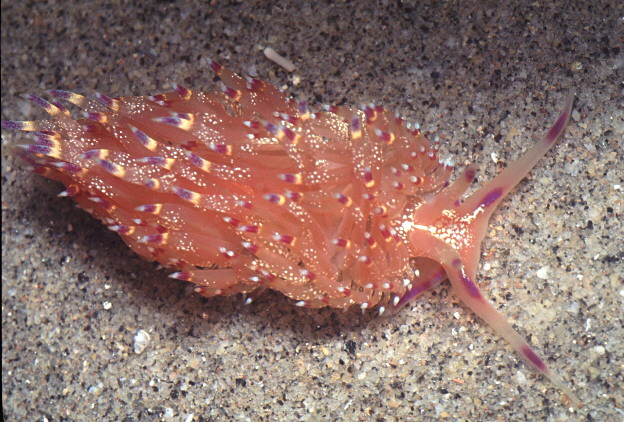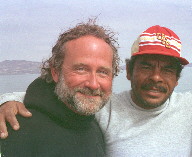 |
Flabellina cynara
Flabellina cynara (Marcus and Marcus, 1967)
During our recent trip to Bahia de los Angeles, Mike Miller told me he wanted to find and photograph the swimming eolid, Flabellina cynara. Since I have been conducting subtidal research on the opisthobranch community in this special place for more than a dozen years, I was immediately able to tell him where we had to dive for our best chance at finding this distinctive slug.
Sure enough, twenty minutes into our dive, we found a specimen of this species crawling on a worm tube covered with the slug's prey hydroids. Quickly we found another, much larger specimen, crawling across the sand. Its cerata were held down on its dorsal surface like a 1960's slicked-down hairdo.
It has long, salmon-orange cerata with white speckling a subterminal purple ring. The border of the foot has a rich purple marginal line. The translucent cephalic tentacles have a distal purple blotch. Maximum body lengths range to about 40-50 mm (one and a half to two inches).
Most memorable is the swimming behavior of Flabellina cynara, which was so brilliantly illustrated by Wesley Farmer in his 1970 paper, "Swimming Gastropods (Opisthobranchia and Prosobranchia)" (Veliger 13: 80-83). The slug uses back-and-forth strokes of its whiplike cerata to propel itself through the water. The cerata gently curl forward in a loosely coordinated flowing movement, pause, and then whip backwards in a simultaneous power wave. The rearward flipping of the cerata is the propulsive stroke. Swimming up into the water column may allow the animal to hitch a ride on the he water durrents, aiding its escape from a predator or its search for prey or a mate. Mike and I picked up the slugs and released them from our hands, encouraging them to swim. As we breathed from our regulators and fiddled with our cameras, each slug performed its ritual swim. We thought they were dancing for us, but the slugs knew differently. They were just doing their own thing!
The know geographic range of this species is limited to the northern Gulf of California, Mexico (Puerto Penasco and Guaymas, Sonora, on mainland Mexico; and Bahia de los Angeles, Baja California)
Text by Dr. Hans Bertsch

| Dr. Hans Bertsch
Assoc. Prof. |
